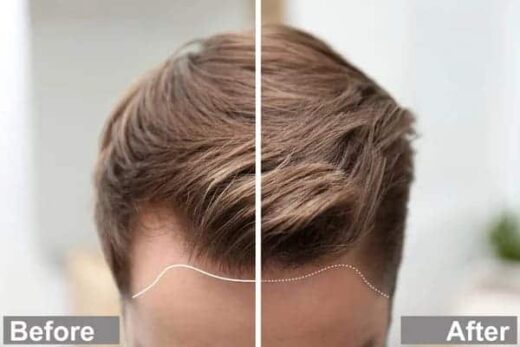A hairline naturally changes over time, and for many men, this transformation begins between the ages of 17 and 27. While a mature hairline is a standard part of aging, a receding hairline is typically linked to hair loss conditions such as male pattern baldness. Differentiating between these two conditions can help in understanding whether hair loss is a natural shift or a sign of more significant thinning.

What is a Mature Hairline?
A mature hairline is a slight shift in the position of your hairline, moving up slightly at the temples. This is a completely normal process that occurs as men grow older. Most men experience this subtle transformation, which results in a more V-shaped hairline, often referred to as a widow’s peak.
Key Characteristics of a Mature Hairline:
- It shifts evenly across the forehead.
- The hairline moves upward by approximately 1 to 2 centimeters.
- The hairline remains defined without patchy thinning.
- It usually stabilizes between ages 25-27.
Unlike a receding hairline, this natural transition does not indicate significant hair loss or thinning in other areas of the scalp.
What is a Receding Hairline?
Unlike a mature hairline, a receding hairline is a form of hair loss that progresses unevenly, often forming an M-shaped pattern. This condition is caused by hair follicles shrinking, leading to weaker hair strands and eventual hair shedding.
A receding hairline is often one of the first signs of male pattern baldness. It tends to start at the temples and progresses over time, potentially leading to more extensive hair loss on the top of the head.
Key Characteristics of a Receding Hairline:
- Uneven movement of the hairline, particularly at the temples.
- Hair loss beyond the normal 1-2 cm retreat of a mature hairline.
- Possible thinning at the crown (top of the head).
- Classified under different stages using the Norwood Scale.
What Causes a Receding Hairline?
The primary cause of a receding hairline is male pattern baldness (androgenetic alopecia), a condition influenced by genetics and hormones. Studies suggest that up to 80% of cases are inherited.
The hormone dihydrotestosterone (DHT) plays a crucial role in this process. Certain hair follicles, especially those around the temples and crown, are more sensitive to DHT. This leads to follicle shrinkage, shorter hair growth cycles, and, eventually, permanent hair loss.
Other Contributing Factors:
- Medical Conditions: Certain illnesses can contribute to hair loss.
- Medications: Some drugs may accelerate hair thinning.
- Hairstyling Practices: Tight hairstyles and chemical treatments can damage hair follicles.
- Lifestyle Choices: Poor diet, smoking, and stress can also contribute to hair loss.
Mature vs. Receding Hairline: A Side-by-Side Comparison
| Feature | Mature Hairline | Receding Hairline |
| Cause | Natural aging | Male pattern baldness (DHT) |
| Hairline Movement | Even retreat of 1-2 cm | Uneven retreat, deeper at the temples |
| Pattern | V-shape (widow’s peak) | M-shape, progressing to bald spots |
| Hair Loss Severity | Minimal thinning | Noticeable shedding and thinning |
| When It Stops | Around age 25-27 | May continue over a lifetime |
Early Signs of a Receding Hairline
Hair loss is a gradual process, but early detection can help slow or even reverse it. Some common signs include:
- More visible forehead: If your forehead appears larger over time, it may indicate hairline recession.
- Uneven hairline retreat: A receding hairline rarely moves back evenly, so check for asymmetry.
- Excessive shedding: If you notice more hair falling out while washing or brushing, this may signal hair thinning.
Can You Prevent a Maturing Hairline?
Since a maturing hairline is a normal part of aging, there is no way to stop it. However, for those who are unhappy with how their hairline looks, a hair transplant can create a straighter, fuller appearance.
Can You Stop a Receding Hairline?
While male pattern baldness is largely genetic, certain treatments can slow down or even reverse hair loss.
Treatment Options for a Receding Hairline
Before considering surgical interventions, there are non-surgical treatments that may help:
- Minoxidil (Topical Treatment)
- Applied to the scalp to stimulate hair regrowth.
- Can strengthen existing hair and slow down hair loss.
- Finasteride (Oral Medication)
- Blocks the enzyme that produces DHT.
- Can reduce hair loss and promote hair regrowth.
- PRP (Platelet-Rich Plasma) Therapy
- Involves injecting platelet-rich plasma into the scalp.
- Stimulates hair follicle regeneration and promotes natural hair growth.
Hair Transplant Options for Receding Hairlines
If hair loss has progressed significantly, a hair transplant is the most effective option for restoring a natural hairline.
Two Common Hair Transplant Techniques:
- FUE (Follicular Unit Extraction):
- Individual follicles are taken from the back of the head and transplanted into thinning areas.
- Leaves minimal scarring and provides a natural look.
- FUT (Follicular Unit Transplantation):
- A strip of scalp is removed from the back of the head, then divided into grafts.
- Suitable for those needing a higher volume of hair transplantation.
Why Erdem Hospital is the Best Solution for Hair Restoration

When it comes to advanced hair transplantation and therapy, Erdem Hospital is a leading choice, known for its state-of-the-art technology and expertise in hair restoration.
Why Choose Erdem Hospital?
✅ Expert Surgeons: Highly skilled professionals specializing in FUE and FUT hair transplants.
✅ Advanced Technology: Cutting-edge equipment ensuring precise and natural-looking results.
✅ Personalized Treatment Plans: Every patient receives a customized approach to their hair loss solution.
✅ Minimally Invasive Techniques: Quick recovery time with natural and long-lasting results.
✅ Comprehensive Hair Therapy: Offering PRP therapy, finasteride, and minoxidil treatments for enhanced hair health.
At Erdem Hospital, you receive more than just a hair transplant—you get a full spectrum of hair loss solutions tailored to your needs. If you’re looking for a trusted hair restoration clinic with a proven track record, Erdem Hospital is your best choice. Contact with us!